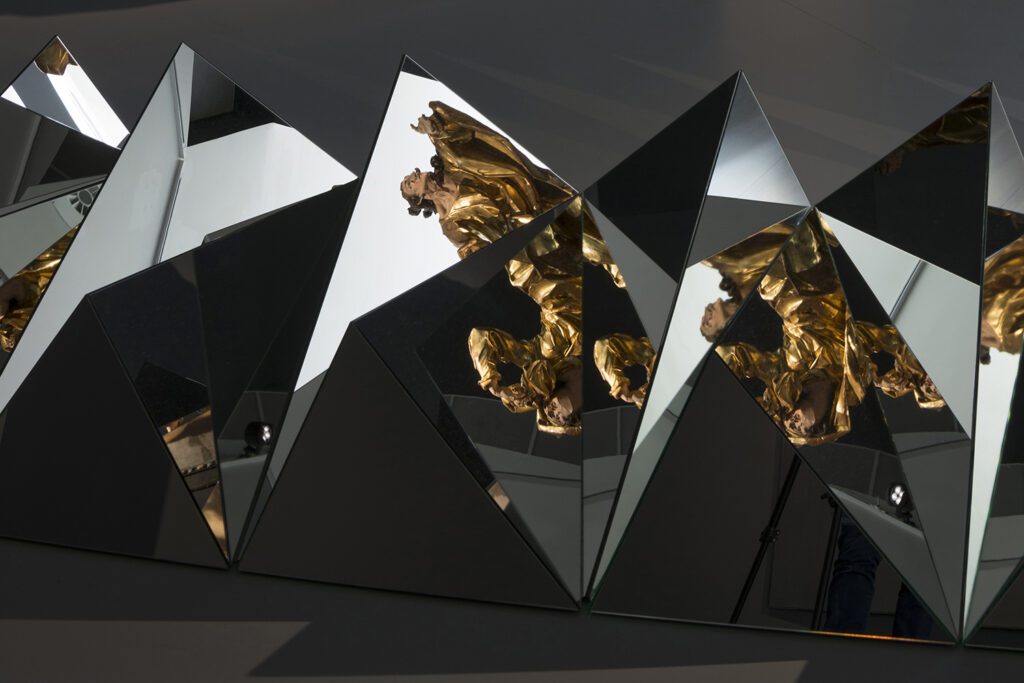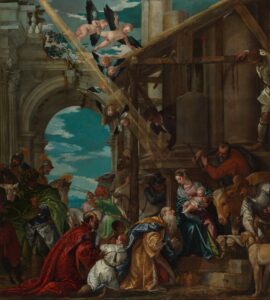
Every year around Christmas, the Diocesan Museum exhibits a Masterpiece. This tradition has been going on for over ten years and this time the painting was the “Adoration of the Magi” by Paolo Veronese, one of the leading lights of the Venetian Renaissance.
The canvas comes from the Santa Corona church in Vicenza and is an immense altar tablet (2,20 x 3,55 meters). It is composed of three vertical tarps. This masterpiece dates back to 1573 and it testifies to the artist’s maturity and the enormous success of his painting techniques, based on chromatic arrangements (light-color) and on the massiveness of the human body. The painting depicts an episode of the Gospel according to Matthew: the Magi, or wise men, who have arrived in Bethlehem from the far east following the comet, contemplate the Divine Infant and, with wide gestures, they demonstrate their devotion. The characters, (monumental figures), are positioned in the foreground just like a theatrical representation; the Holy Family is placed in an edge of the painting, higher than the Magi. The various characters gently glance at each other, making the narration even more real and intimate. The sky which rises above the scene is rather cloudy, but a ray of sunshine comes out and illuminates Jesus. This represents the divine power that tears the world’s darkness. The scene is joyfully completed by Cherubs and Seraphim dancing. The Holy Family is sheltered by simple wood beams, connected to marble Palladian pillars (symbol of the overcoming of the pagan world after the advent of Christianity). While everything is silent in the foreground, in the back, a parade is approaching: archers, halberdiers, domestic and exotic animals, are all part of a scene so eventful and truthful that it’s almost possible to hear the various voices and sounds. There is also a hound dog, present in almost every one of the artist’s pieces.

The Magi are holding precious objects and are wearing extraordinarily elegant clothes. The ancient king is wearing the “golden cloak”, usually worn by Dukes during solemn commemorations, the young king, who is standing, is wearing a cape made by the finest red velvet, and finally the Moor king is wearing another cape, blue and lined with ermine fur. The colors of their clothes are gaudy, flamboyant, and they show how talented the artist was. He painted mixing colors over other colors, with rapid strokes for the light and more fluid ones for the shadows. This resulted in a combination of clear and brilliant tints. The clothes worn by the Magi are a sample of the precious fabrics that the sponsor of the art piece (Marcantonio Cogollo, fabric merchant from Vicenza) wanted to promote. Cogollo himself can be found on the left side of the painting and, although he is on the sidelines, the wealth and importance of his family are further highlighted by the emblems of their House painted on the blinders of a horse.
Even though the painting is representing a holy event, there are so many curious details and artistic inventions, that the story almost appears as a pagan celebration. By interpreting the Gospel in this peculiar way, Veronesi had to face many problems with the religious authorities and the Inquisition court. The artist recreated many copies of the “Adoration of the Magi”, one of which can be found in the National Gallery in London and is very similar to the one from Vicenza.
In the early 1800s, the Napoleonic troops that arrived in Italy dismantled the canvas in order to move it elsewhere. For many years, the masterpiece’s location remained unknown but luckily it was eventually found and placed in its actual location (Saint John’s chapel in Santa Corona church), so that everybody can admire it and feel what the architect Bertotti Scamozzi said in 1700: “This is a very special joy and those who haven’t seen it can say they haven’t seen painting’s perfection.”
Laura Pettinato
Volume 33 no 5 May /June 2019

